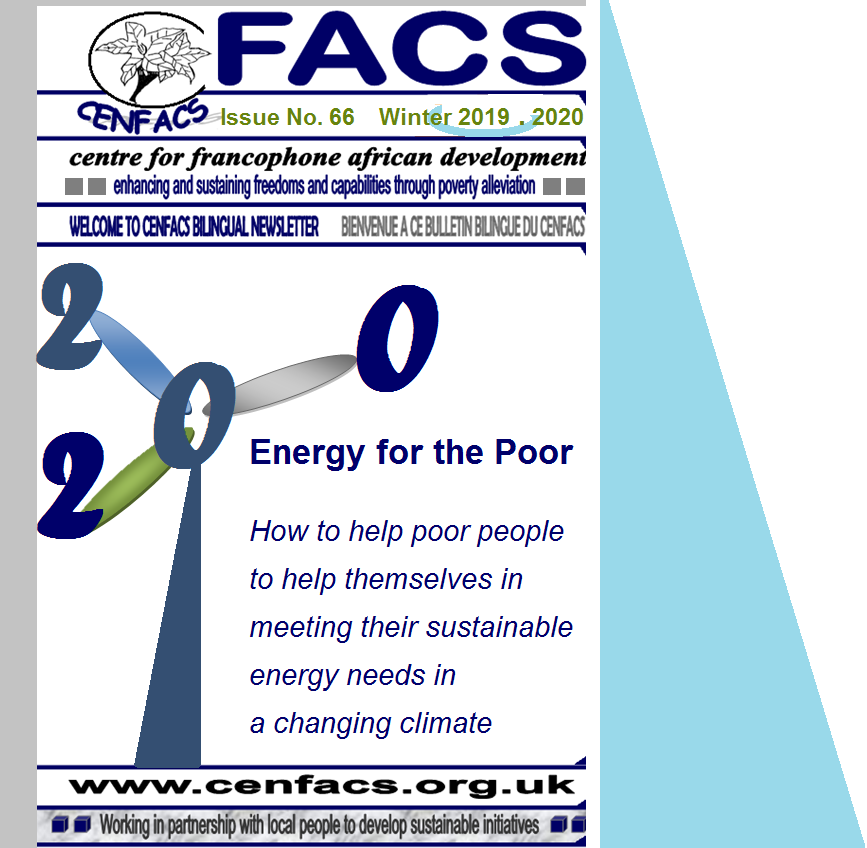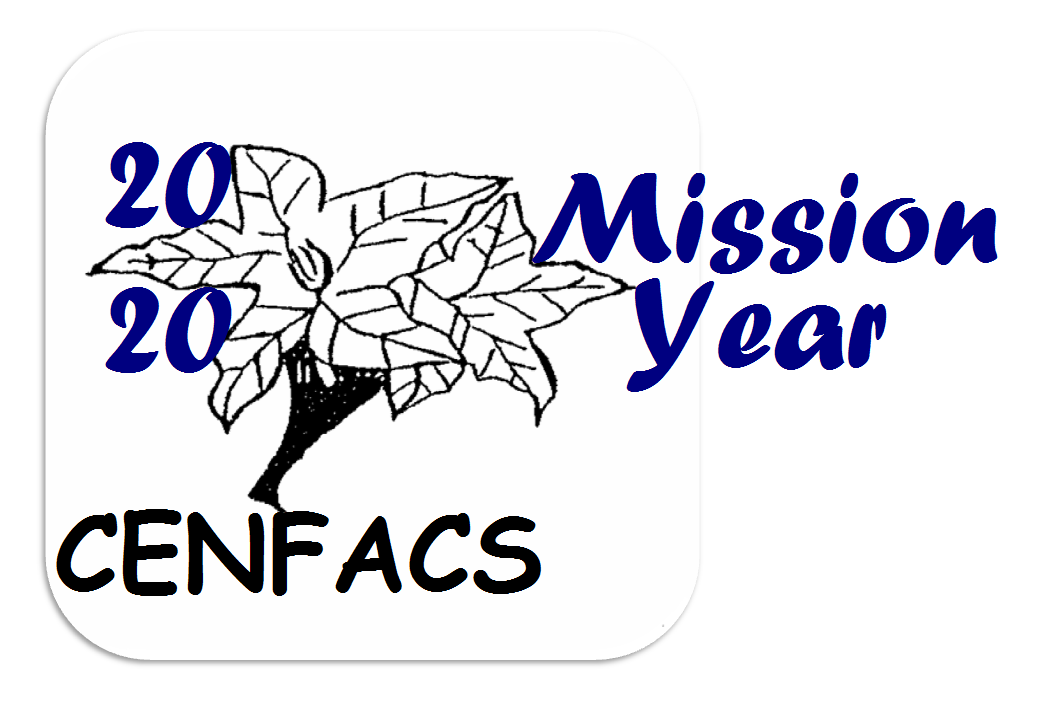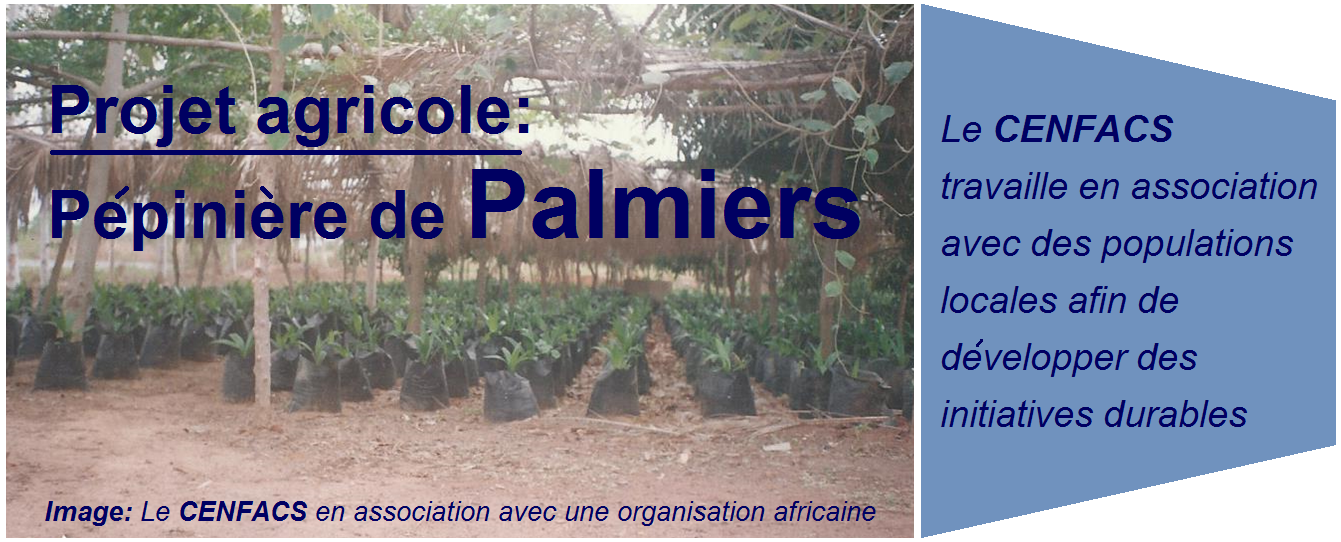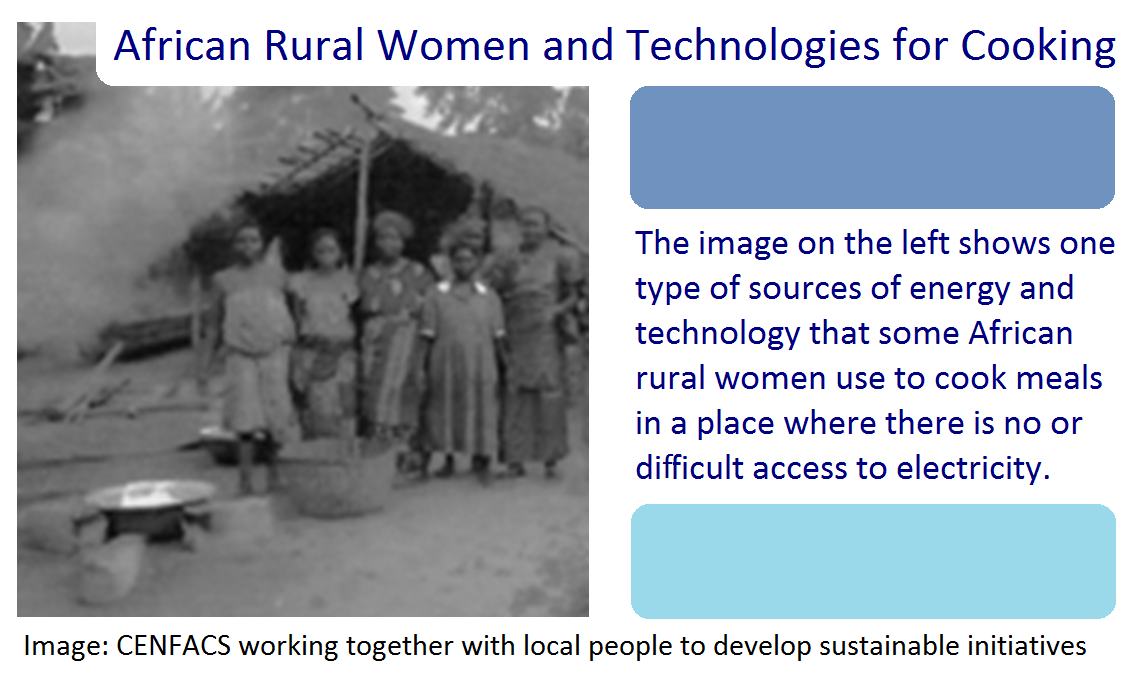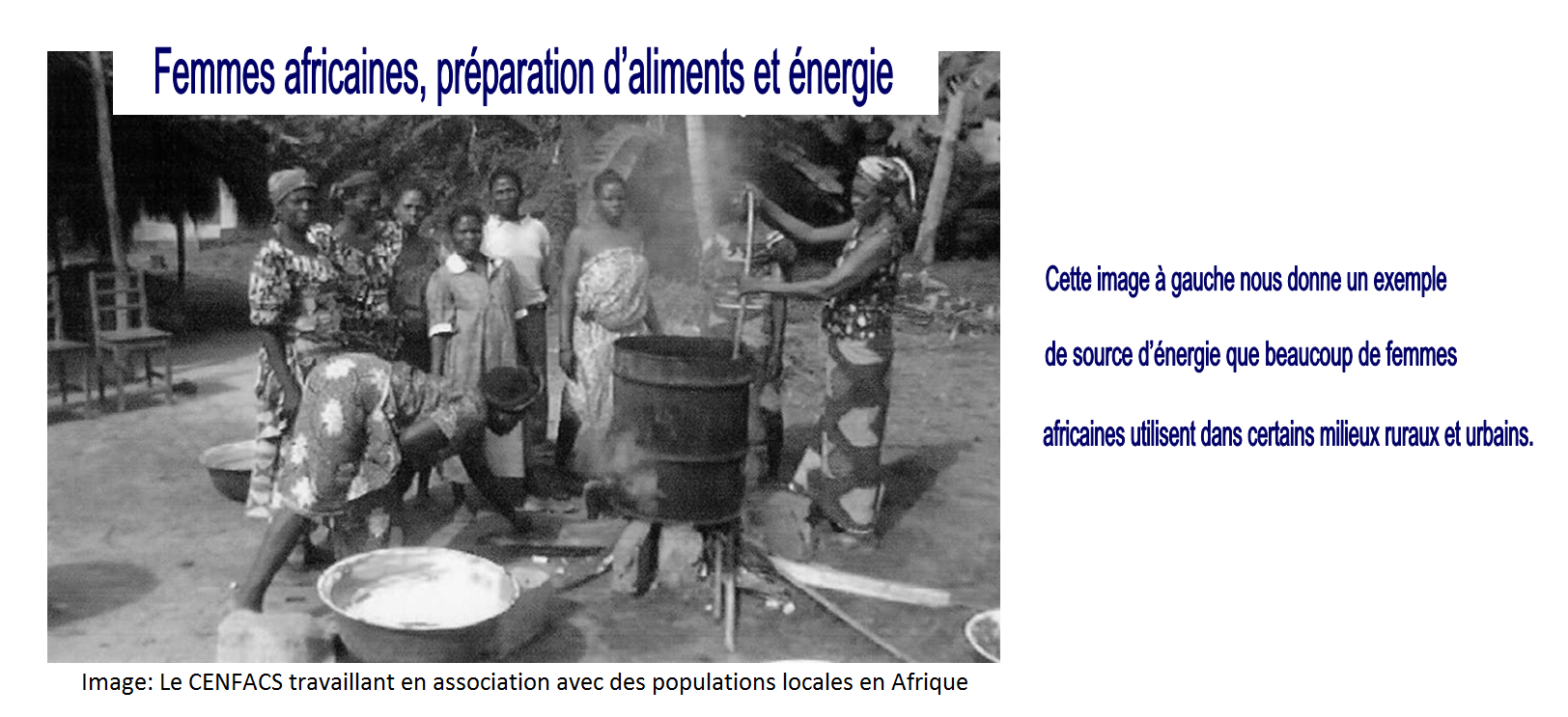Welcome to CENFACS’ Online Diary!
22 January 2020
Post No. 127
The Week’s Contents
• Key Summaries of FACS Newsletter, Issue No. 66 entitled as Energy for the Poor
• Digital and Social Media Campaigns – Level 3: Digital Infrastructure, Security and Defence
• Gifts of Peace: Only 9 Days to Create Life-Changing Magic of Peace
… and much more!
Key Messages
~ Key Summaries of FACS Newsletter, Issue No. 66 entitled as…
Energy for the Poor –
How to help poor people help themselves in meeting their sustainable energy needs in a changing climate
The 66th Issue of FACS, which is about Energy for the Poor (How to help poor people to help themselves in meeting their renewable energy needs in a changing climate), is now ready for your readership.
In our post no. 124 of the 1st of January 2020, we introduced this 66th Issue. In this week’s post, we have summarised the key contents making the pages of this Issue. Under the Main Development section of this post, you will find the key summaries of the Issue. For those who would like to learn more about the Issue and beyond these key summaries, please free to contact CENFACS.
~ Digital and Social Media Campaigns – Level 3: Digital Infrastructure, Security and Defence
As part of level 3 of digital and social media campaigns, we are working on affordable budget to help people build basic digital infrastructure, security and defence.
Digital infrastructure is understood as the permanent services and equipment needed to be able to function digitally. They include: computers, laptops, internet connections and networks, software and hardware, tablets, phones, etc.
Digital security is the protection from digital harms; against attacks, threats and theft of any kinds (such as hacking, spyware, etc.).
Digital defence is equipment or method or even means to protect against attacks and threats of any kinds.
The above three areas of the level 3 of our Digital and Social Media Campaigns can be translated into a budget; that is plan specifying the way money will be coming and spent or allocated for these three areas. In the context of this budgeting exercise, we have provided an example of a basic personal expenses budget for digital infrastructure, security and defence (Figure 1).
~ Gifts of Peace: Only 9 Days to Create Life-Changing Magic of Peace
Our Gifts of Peace highlighting the Season of Giving will soon reach the deadline. We continue to appeal to those who did not have the opportunity to donate by telling them that there are only nine days remaining to create a Life-Changing Magic of Giving something for sustainable peace.
We hope you will keep these Gifts of Peace in your minds and help us reinvigorate the giving season through your donation or Gift of Peace.
Extra Messages
~ Transitional Development Programme and Africa-based Sister Organisations in Democratic Transitional Places of Africa
This week, we are also looking at how Africa-based Sister Organisations (ASOs) operating in democratic transitional places (like the Democratic Republic of Congo, Algeria) are doing. As part of this exercise, we are trying to find answers about the following questions:
Is democratic transition working for them and their project beneficiaries?
What obstacles are they facing and is there any new space or window of opportunities for their work since the process of transition began?
How can we support them in their difficult mission of helping to reduce poverty, especially as we are in Mission Year at CENFACS?
As everybody knows, every process (like democratic transition) comes with opportunities and threats. It can work some people and organisations; just as it may not work for others. This is what we are trying to find out through our Transitional Development Programme.
For those organisations working in places that are undergoing democratic transitions in Africa, we would be more than pleased to hear from them their experiences of democratic transitions so far, especially on how it has impacted their work.
If you have experience to share from democratic transition places in Africa, please do not hesitate to share it with CENFACS.
~ News from the Field
Some of our Africa-based Sister Organisations are arguing that democratic transition in Africa is a long process in order for it to be translated into tangible benefits on the grounds. Places or countries which are in transition (like the Democratic Republic of Congo), they still need institutional change and some fresh or retrained human resources. The institutions and administrations of poverty reduction need to be rebuilt and resourced.
While the rebuilding is going on, the dividends from democratic transitions may take time to be translated into concrete poverty reduction on the grounds. However, this does not stop ASOs to continue their work in supporting those in need.
ASOs also admitted as governing systems open up to the public and public scrutiny, the box of poverty Pandora is opened as well; that is the scale and magnitude of poverty problem become more visible as dictatorial administrations were tried to hide these problems.
They finally highlighted some other issues such as the disruption of transition and poverty relief work by the eruption of sectarian conflicts and climate change issues, the rebuilding of poverty reduction infrastructures and structures, governance issues as some administrations continue to behaviour like in the past, the longer the democratic transitions take the more delay in poverty reduction work (in countries like Algeria).
The above is just the news from the field we have so far. For those who have been doing fieldwork or visited projects in Africa, if you have any news; we would be grateful if you could share it with us. Thank you!
~ Mission Year and Energy for the Poor
As we announced at the start of this year, 2020 is CENFACS’ Mission Year and we shall reflect this missionary feature on most of the work we will carry out this year.
As an example of the application of the Mission Year, we are going to reflect this year’s dedication to the general theme of the 66th Issue of FACS newsletter, theme which is energy poverty. In this respect, we can work with energy poor to help them come out energy poverty.
Apart from other works we have scheduled for this week, we have embarked on a mission to help relieve energy poverty. To do that we need to understand what energy poverty means.
To understand it, we are going to borrow its definition from the European Commission (1) that uses the “Grenelle II” Act which defines energy poverty as
“a situation in which a person has difficulty obtaining the necessary energy in their home to meet their basic needs because of inadequate resources or living conditions”.
From this definition, our poverty-relieving mission would revolve around finding out answers to the following two questions:
Who is energy poor within our community?
How can we work together with energy poor and help them to help themselves to meet their sustainable energy needs in a changing climate?
The above is the kick start of our Mission Year and Project.
(1) https://ec.europa.eu/energy/en/content/possible-approach-define-energy-poverty-inability-keep-home-adequately-warm
Main Development
• Key Summaries of FACS Newsletter, Issue No. 66 entitled as…
Energy for the Poor –
How to help poor people help themselves in meeting their sustainable energy needs in a changing climate
• • Contents and Pages
- African People and Access to Electricity (Page 2)
- The Price of Woods on African Forests and Biodiversity (Page 2)
- Women, Health, Energy and Carbon Print in a Changing Climate in Africa (Page 3)
- Energy Choices by Poor People (Page 3)
- Africa-based Sister Organisations, Solar Resources and Poverty Reduction (Page 4)
- Africa-based Sister Organisations, Production of Energy Technologies, Energy Transition and Poverty Reduction (Page 4)
- Africa-based Sister Organisations, Less Carbon-intensive Poverty-relieving Path and Poor People (Page 4)
- Comment réduire les pressions sur l’exploitation forestière aux besoins en énergie en Afrique (Page 5)
- Comment faire que l’abondance africaine de ressources en énergies renouvelables atteigne les pauvres (Page 6)
- Comment assurer un développement moins carboné qui répond aux besoins énergétiques des pauvres en Afrique (Page 6)
- Africa-based Sister Organisations and the Development of Basic Affordable Renewable Energy Infrastructures to Combat Climate Change and Poverty (Page 7)
- Africa-based Sister Organisations and the Development of Local Energy Technologies to Combat Poverty and Precariousness (Page 7)
- Integrating Renewable Energy and Mobile Money Payment for the Poor (Page 8)
- Redrawing the Map of Poverty in Africa through Investment in Biofuel Energies (Page 8)
- Natural Resources, Renewable Energy Technologies and Poverty Reduction (Page 9)
- Energy Transition is a Key to Poverty Reduction in Africa (Page 9)
- Energy Connections Project (Page 10)
• • Key Summaries
Please find below the key summaries of the 66th Issue of FACS from page 2 to page 10.
African People and Access to Electricity (Page 2)
It is argued that half of African population has no access to electricity. For example the World Bank (2) argues that
“Sub-Saharan Africa remains the region with the largest access deficit… 573 million people – more than one in two – lack access to electricity”. (p.4)
The same institution says that
“In 2030, around 40% of the access-deficit population will reside in Sub-Saharan Africa”. (p.67)
If this is the case, then there is a need to meet the electricity needs of the electricity-deprived people in Africa. However, if they are using an alternative source of power to cover the lack of access to electricity, then these poor people may have problem to transition from those sources to electricity. This could require energy projects or schemes that make electricity affordable for them (e.g. electricity access token scheme for basic needs of cooking).
The Price of Woods on African Forests and Biodiversity (Page 2)
Research found that 2/3 of African population depends on coal from wood to cook at the expense of forests and biodiversity. In other words, woods have been cut in forests and biodiversity has been altered in order to make human needs of energy for cooking. If this is done at a rate and pace that do not destroy the environment or lead to further increase in greenhouse gas emissions, that is fine!
At the moment, this is not the case and does not solve the problem of poverty. In reality, the way in which woods are cut, forests have been exploited and biodiversity has been treated continue to put an heavy price on the African environment and on the future generations, let alone natural events such as forest fires because of heat due itself to climate change.
Women, Health, Energy and Carbon Print in a Changing Climate in Africa (Page 3)
In rural and urban areas of Africa woods are often used as source of energy to make fire to cook and heat. There is a tendency to use polluting fuels and technologies for cooking. For example, the Word Bank thinks that
“In Sub-Saharan Africa, around 900 million people would still rely on polluting fuels and technologies for cooking in 2030”. (p.105)
Amongst those who use woods for household purposes are women. They use it cook since cooking is part of women’s role in most African societies. Often these women are exposed to smokes from the fire. This exposure can even be worst when the meal is prepared for a large number of family members who include extended families. It is as well worst when the meal is cooked for a family or community event.
Regular exposures to smokes can cause breathing (respiratory diseases) and eye problems. Besides this human health issue, there is also the environmental health issue linked to greenhouse gas emissions because of regular smokes. This does not create a carbon neutral place for those living in this type of environment.
In the context of changing climate and life-threatening impacts of climate change, it is possible to improve the source of energy used by these women so that they can cook by using non-polluting fuels and technologies. It is possible to support those populations through various forms of renewable energy so that they can transition to a less carbon way of cooking their meal.
Energy Choices by Poor People (Page 3)
Whether we speak about fossil fuels or carbon neutral energy, it is all about choices. Those who are poor and difficult-to-reach may not have choices, but to take the option dictates by their conditions of life. Amongst them are the peoples without access to clean cooking solutions.
However, there are things that can be done to create a number of choices or options for them. These choice-creating initiatives could include things such as boosting their incomes, energy education of the poor, income-generating activities geared towards energy choices, raising awareness of energy choice to help them to access energy mix, etc.
We can continue to list these initiatives, but at the end of the day, one needs to develop a clear inclusive strategy that gives energy choices for poor people while making sure that this strategy is deliverable.
Africa-based Sister Organisations (ASOs), Solar Resources and Poverty Reduction (Page 4)
It is well known that Africa is rich in solar resources. It is also a matter of fact that poverty is higher in Africa compared to other regions of the world. Given the two facts, ASOs need to continue to work with beneficiaries and interested people and communities so that they can match the richness of solar resources to the high level of poverty within these communities. They can align their outputs with their efforts to reduce poverty via solar projects or activities (that use energy from the sun) within those communities in need. For example, communities can invest in solar cooking through solar oven.
Africa-based Sister Organisations (ASOs), Production of Energy Technologies, Energy Transition and Poverty Reduction (Page 4)
It is said that Africa has the potential to produce critical technologies for energy transitions. As a home to these technologies, Africa also faces the challenge of reducing poverty. ASOs can continue to work with local people and communities to produce those critical technologies needed for energy transitions. These technologies are also required to reduce poverty within the same communities.
They can set up energy transitions projects to that effect. To keep track on that direction, resilience and close cooperation are needed between these organisations and the community they serve or work with.
Africa-based Sister Organisations (ASOs), Less Carbon-intensive Poverty-relieving Path and Poor People (Page 4)
Less carbon-intensive path for the reduction of poverty is one of the campaigns many would like to see in the work of our ASOs. ASOs could keep helping poor people reduce poverty by using a path or scheme that involves less the use of carbon.
Many organisations are already engaged in this kind of work or path. We hope many others will follow suit. Those who are already engaged in this model of poverty reduction would recognise that poor people try and find difficult to adjust to this model as the means do not always justify the ends.
For example, switching from charcoal to solar energy is not always obvious. This effort requires as well energy education of the local population while developing some incentive initiatives to motivate them. One of these incentives could be to create local heroes in clean energy or a voucher system to encourage people to use clean energy.
Comment réduire les pressions sur l’exploitation forestière aux besoins en énergie en Afrique (Page 5)
Pour des populations qui ne sont pas aussi industrialisées comme les autres et qui dépendent largement de l’agriculture, l’exploitation naturelle ou forestière représente le moyen primordial de remplir les besoins de première nécessité tels que ceux d’énergies, d’aliments, de vêtements, etc.
L’approvisionnement en énergie pour ces populations tente d’être basé sur l’utilisation ou l’exploitation naturelle. Ce qui est le cas en Afrique là où il y a des forêts immenses et des richesses forestières. L’exploitation forestière en soi n’est pas mauvaise. Cette exploitation devient un problème quand ces mêmes populations commencent à exercer des pressions sur des richesses forestières pour remplir des besoins énergétiques, et si ces pressions créent des problèmes sur l’environnement; problèmes tels que l’effet de serre ou les feux de brousse ou le dérèglement climatique.
Dans ce cas là, il y a lieu de réduire ces pressions sur les ressources et réserves forestières en développant des solutions alternatives en matière d’énergie pour subvenir à ces mêmes besoins énergétiques.
Aujourd’hui avec des recherches et la montée des technologies énergétiques nouvelles, il y a un éventail d’alternatives pour assurer les besoins énergétiques.
Comment faire que l’abondance africaine de ressources en energies renouvelables atteigne les pauvres (Page 6)
L’afrique regorge pas mal des ressources énergétiques renouvelables telles que hydro-électriques, biomasses, géothermiques, solaires, etc. Le barrage hydro-électrique d’Inga dans la République Démocratique du Congo est un exemple parmi tant d’autres qui constitue un cas frappant de cette abondance.
Néanmoins, ces énergies n’atteignent pas toutes les couches de populations, et en particulier les pauvres; ressources que contient l’Afrique. Cela étant, pour effectivement réduire la précarité ou pauvreté énergétique en Afrique, il faut faire en sorte que la distribution ou répartition des énergies atteigne les couches des populations les plus démunies d’énergie.
Dans le siècle passé, il y avait des projets et discours sur cette question. Néanmoins, la plupart de ces travaux ou tentatives sont restés letter morte ou ont abouti à des échecs. D’aucuns peuvent penser que la nouvelle décennie peut être celle non seulement de la transition énergétique en Afrique, mais aussi celle des énergies renouvelables et durables pour tous et toutes en Afrique.
Comment assurer un développement moins carboné qui répond aux besoins énergétiques des pauvres en Afrique (Page 6)
Il y a plusieurs modèles de développement. A l’heure des inquiétudes des effets néfastes des changements climatiques, la majorité des économistes de l’environnement se tourne vers un développement moins carboné, c’est-à-dire à un processus de changement meilleur qui implique de moins en moins l’utilisation des produits et activités créant l’effet de serre.
Assurer que ce type de développement se réalise est une chose et non pas une fin en soi. Une autre chose, c’est de faire en sorte que ce processus répond aux besoins et attentes, particulièrement mais pas exclusivement, énergétiques des pauvres. Autrement dit, point n’est besoin d’embrasser un modèle de développement de-carboné qui ne répond pas aussi bien aux besoins de la nature qu’à ceux de ceux qui souffrent.
Pour y parvenir, il faudrait que ce modèle intègre la dimension réduction de la pauvreté. Cette intégration se fera sur des bases saines en ayant clairement défini ses prémices, fins, prémisses, régime ou mode de fonctionnement, objectifs et buts finaux. Car, c’est seulement en adoptant une approche intégrative ou holistique que le développement moins carboné répondrait aux attentes des générations humaines d’aujourd’hui et d’avenir.
Africa-based Sister Organisations (ASOs) and the Development of Basic Affordable Renewable Energy Infrastructures to Combat Climate Change and Poverty (Page 7)
To fight the adverse impacts of climate change and to reduce poverty, it requires the development of infrastructures. While major infrastructures (such as hydroelectric powers and plants) could be the domain or responsibility of governments, small scale infrastructures and capacities could be done by individuals, small organisations and local communities.
ASOs could work together with local people and communities to set up basic renewable energy infrastructures and structures that can help these energy-deprived communities to reduce greenhouse gas emissions linked to the type of energy they use. This can as well help to reduce energy poverty and other types of poverty (such as income, consumption, multi-dimensional, etc.). This is because in the fight of climate change and poverty, small initiatives but well planned and better implemented can make a big difference to those living in poverty and being the victims of the negative impacts of climate change.
It is in the development of this kind of infrastructures and structures that sustainable energy needs of these poor people can be met in a changing climate.
Africa-based Sister Organisations (ASOs) and the Development of Local Energy Technologies to Combat Poverty and Precariousness (Page 7)
To combat poverty and hardships, it requires an arsenal of tools, strategies or solutions. One of them is the creation of new ideas and technologies at local and people levels to help reduce poverty.
Developing local energy technologies can help to respond to some of the energy challenges. So, ASOs that are working together with local people in the development of sustainable and renewable energy micro-projects can help alleviate poverty.
Working with locals on energy matters could make energy cheaper as energy products and services are made and run by locals, local organisations and from local resources. This is even obvious when local energy has a competitive and comparative advantage.
Integrating Renewable Energy and Mobile Money Payment for the Poor (Page 8)
There are countless problems that poor people face in Africa. In this article, we would like to highlight two of them which are: money and the way of the paying for renewable energy.
The mobile money account or system can help alleviate this as it facilitates the transfer of money to poor people while enabling to pay for renewable energy if they can afford and have money in their account. An example of this integration scheme or process is with solar panel.
Redrawing the Map of Poverty in Africa through Investment in Biofuel Energies (Page 8)
Investing in biofuel energies can help to get the picture of poverty and those experiencing it. It can allow having more data about poverty, especially fuel poverty. It can help to find out those who have access to clean fuels and technologies and those who do not have.
This kind of investment can signal the level of poverty that some people may face. For those of our Africa-based Sister Organisations (ASOs) that want to take that path, it will be interesting through this kind of investment to draw a map showing those who receive or not this investment and measure the chance or probability that each of them has to come out from poverty or at least energy poverty.
Natural Resources, Renewable Energy Technologies and Poverty Reduction (Page 9)
It is possible to reduce poverty by drawing on rich natural resources and advances in renewable energy technologies to meet the energy demand of the poor in Africa. The revenues from the sales of natural resources (such as oil, gas and minerals) can help to develop or acquire renewable energy technologies to reduce poverty.
Those working on poverty reduction can advocate for a fair share of revenues from the sale of natural resources to be allocated to the development of renewable energy technologies. African organisations can step up a case for this to happen, especially in places where this is not seen as priority.
This matter provides an opportunity to campaign and prioritise the fair share of revenues from the sale of natural resources to be allocated to new and improved renewable energy technologies conducive to the reduction of poverty. In doing so, one can begin to see the causal link between revenues from natural resources, renewable energy technologies and poverty reduction in Africa or elsewhere.
Energy Transition is a Key to Poverty Reduction in Africa (Page 9)
Energy transition is the move from fossil fuels (i.e. non-renewable resources such as coal, oil and natural gas) to renewable energy (that is, materials and energy sources that can be used over and over again).
Moving from fossil-based to zero-carbon economy can help to reduce poverty in Africa. Indeed, by restructuring the way in which energy is produced, consumed and distributed (especially in shifting to renewable and sustainable forms of energy); this can enable to create a balanced energy that could reach poor people. However, this move requires a preparation to avoid both cultural and psychological chocks, even social conflicts like the ones we are seeing in France with the so-called yellow vests.
African voluntary organisations can take the lead on this and set up a model of energy transition projects to help move in that direction. In any transition, there are opportunities and challenges. African organisations need to take these opportunities. In the long run, may be the benefits resulting from opportunities used will overweigh the threats and risks linked to challenges.
Energy Connections Project (Page 10)
This is a low carbon-intensive project that aims at reducing renewable energy poverty and hardships amongst poor people and communities in Africa by helping them to access to a network and development of renewable energy support (such as tools, skills, knowledge, capacity development, etc.) in order to reduce pressures on natural resources (forest resources and exploitation) and biodiversity.
For details including full project proposals and budget, please contact CENFACS
The full copy of the 66th Issue of FACS is available on request. For any queries and comments about this Issue, please do not hesitate to contact CENFACS.
(2) https://sustainabledevelopment.un.org/content/documents/2019_tracking_sdg7_reportpdf
Help CENFACS keep the Poverty Relief work going in 2020.
We do our work on a very small budget and on a voluntary basis. Making a donation will show us you value our work and support CENFACS’ work, which is currently offered as a free service.
One could consider a recurring donation to CENFACS as a New Year’s resolution.
Donate to support CENFACS!
FOR ONLY £1, YOU CAN SUPPORT CENFACS AND CENFACS’ PROJECTS, JUST GO TO http://cenfacs.org.uk/supporting-us/
Thank you for visiting CENFACS website and reading this post.
Thank you as well to those who made or make comments about our weekly posts.
We look forward to receiving your regular visits and continuing support in the New Year and New Decade as well.
With many thanks.
